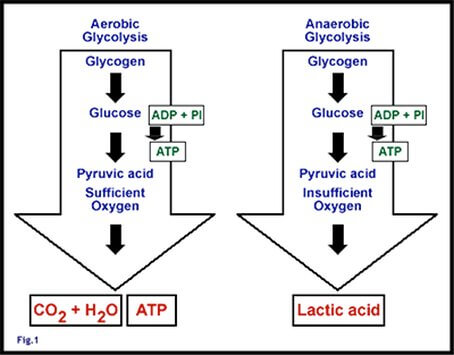Glucose Metabolism
Published (updated: ).

The body is dependent upon two processes to create energy at rest and during exercise, aerobic and anaerobic metabolism. Simplified, the aerobic metabolic system uses oxygen, while the anaerobic system does not; however, oxygen plays a vital role in allowing the body to function under both systems.
Both the aerobic and anaerobic systems occur simultaneously; there is no switching from one to the other. Whether the aerobic or the anaerobic system is dominant depends on the amount of muscle oxygen available.
Muscle Oxygen
The term muscle oxygen refers to the balance between the supply and demand of oxygen in the muscle. For example, when demand is exceeded by supply, oxygenation is low, and the muscle requires anaerobic metabolism to provide energy. In the opposite case, when supply exceeds demand, oxygenation is high, and the muscle is able to use aerobic metabolism to power itself.
Aerobic Metabolism
Aerobic metabolism fuels most of the energy needed for long duration activity. The aerobic metabolic system functions using the Krebs Cycle, a complex series of chemical reactions that use oxygen to convert nutrients (carbohydrates, fats, and protein) to carbon dioxide and adenosine triphosphate (ATP), an energy-rich compound.
Aerobic metabolism relies on the circulatory system to transport oxygen to the working muscles before it creates ATP. Aerobic metabolism is used primarily during endurance exercises which are typically less intense and can therefore continue for longer periods of time.
Anaerobic Metabolism
Anaerobic metabolism, on the other hand, occurs during short bursts of high intensity exercise, when the oxygen demands of muscle tissue exceed the capacity of the circulation to supply, creating oxygen debt. If the oxygen debt becomes too high, the muscle is no longer able to function. The only way to recover the muscle is to provide it with oxygen-rich blood in order to oxygenate the excess lactic acid. This is usually achieved during a recovery period in a workout.
Many people confuse the concepts of blood lactate and lactic acid. Lactate is produced as a byproduct of the energy system but is completely harmless; in fact, it is actually used as fuel by the heart and muscles. Even at rest, the body produces lactate, though quantities increase with exercise. Lactic acid, however, is a byproduct of lactate buildup and causes acidosis to increase in the system.
The Bottom Line
Oxygen plays a vital role in both the aerobic and anaerobic metabolic systems. While oxygen is required as a direct energy source in the aerobic system, it is also essential in clearing the blood of excess lactic acid buildup in the anaerobic system.
